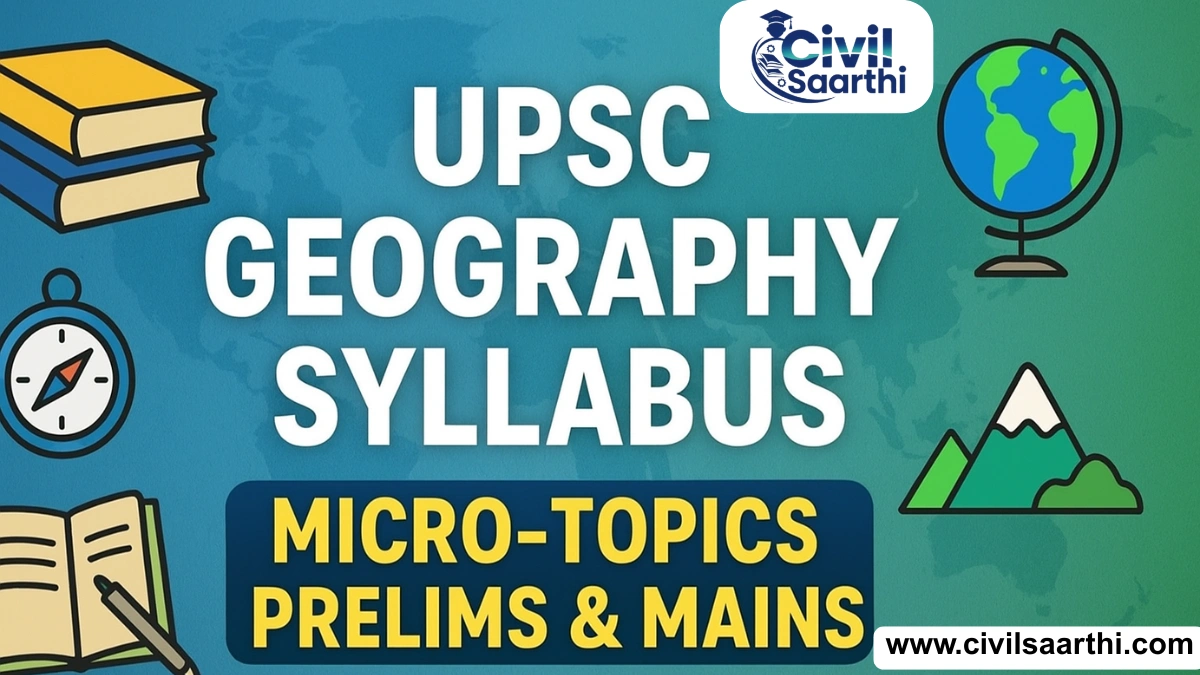Geography is one of the most important subjects for UPSC Civil Services Examination. It covers both Prelims and Mains and is closely linked with current affairs. A proper understanding of geography micro-topics helps in effective preparation and answer writing. In this article, we will explore the UPSC Geography Micro-topics syllabus, download options for PDF, recommended booklist, and preparation tips.
UPSC Geography Micro-topics Syllabus
The UPSC Geography syllabus is divided into Physical Geography, Human Geography, and Indian Geography. Each section has multiple micro-topics which are asked repeatedly in both Prelims and Mains. For Mains, Geography appears in General Studies Paper I and also as an Optional Subject.
UPSC Geography Micro-topics Syllabus Overview
The table below provides a detailed overview of the geography micro-topics in Prelims and Mains:
| Section | Micro-topics | Coverage |
|---|---|---|
| Physical Geography | Geomorphology, Climatology, Oceanography, Biogeography, Environmental Geography | Both Prelims & Mains |
| Indian Geography | Resources, Agriculture, Industries, Population, Urbanization, Transport & Communication | Prelims & Mains |
| Human Geography | Economic Geography, Cultural Geography, Settlement Geography, Population Studies | Mostly Mains |
| World Geography | Continents, Regional Geography, Trade & Transport, Geopolitical Issues | Mains focused |
| Current Affairs Linkage | Natural Disasters, Climate Change, Environmental Issues, Location-based questions | Prelims & Mains |
UPSC Geography Syllabus Micro-topics PDF Download
A compiled PDF of UPSC Geography Micro-topics is highly useful for revision. It includes topic-wise categorization for Prelims and Mains. Candidates can use it to track preparation, mark important areas, and integrate current affairs.
Click here to Download UPSC Syllabus Subject-wise Micro-topics PDF
UPSC Geography Micro-topics Syllabus Detailed
1. Physical Geography of the World
- Earth: shape, latitude-longitude, motions (rotation, revolution).
- Earth’s interior: crust, mantle, core, seismic waves, earthquakes.
- Rocks: igneous, sedimentary, metamorphic.
- Plate tectonics: continental drift, sea-floor spreading, major plates.
- Volcanoes: types, distribution, landforms.
- Earthquakes: causes, distribution, measurement (Richter, Mercalli).
- Weathering and erosion: mechanical, chemical, biological processes.
- Agents of erosion: rivers, glaciers, winds, sea waves.
- Landforms: fluvial, glacial, aeolian, coastal, karst.
- Extra additions: recent Turkey earthquake 2023–24, volcanic eruptions and UPSC current affairs link.
2. Climatology
- Atmosphere: composition, layers, significance.
- Insolation: factors affecting, heat budget.
- Temperature distribution: inversions, isotherms.
- Pressure belts and winds: planetary, monsoon, westerlies, local winds.
- Jet streams and their role in Indian monsoon.
- Humidity, clouds, rainfall types.
- Cyclones: tropical and temperate, recent examples.
- El Niño, La Niña, IOD, monsoon variability.
- Climate classification: Koppen, Thornthwaite.
- Extra additions: link between climate change and extreme weather events in India.
3. Oceanography
- Ocean relief: continental shelf, slope, abyssal plains, ridges, trenches.
- Ocean currents: Pacific, Atlantic, Indian Ocean systems.
- Tides: types, significance.
- Marine resources: biotic, abiotic, energy.
- Coral reefs: types, distribution, threats.
- Marine pollution and conservation.
- Extra additions: deep-sea mining debates, International Seabed Authority, Arctic sea routes.
4. Biogeography and Environment
- Ecosystem: components, functions, productivity.
- Biogeochemical cycles: carbon, nitrogen, water.
- Biomes: forest, grassland, desert, tundra, marine.
- Biodiversity: types, hotspots, threats.
- Conservation: in-situ (biosphere reserves, national parks, wildlife sanctuaries), ex-situ (zoos, gene banks).
- Endangered species and IUCN categories.
- Extra additions: new Ramsar sites in India, Cheetah reintroduction at Kuno National Park.
5. Human Geography (World)
- Man-environment relationship.
- Population: distribution, density, growth, migration.
- Settlement geography: rural and urban types.
- Resources: renewable and non-renewable.
- Economic activities: primary, secondary, tertiary, quaternary.
- Industrial regions: Ruhr, Great Lakes, Japan, China.
- Agriculture types: shifting, subsistence, plantation, commercial, dairy, Mediterranean.
- Transport and communication networks.
- Extra additions: global demographic shifts (aging in Japan, youth bulge in Africa).
6. Indian Physical Geography
- Geological structure: Peninsular block, Himalayas, Indo-Gangetic plain.
- Physiographic divisions: mountains, plateaus, plains, coastal, islands.
- Rivers: Himalayan and Peninsular systems, interlinking projects.
- Lakes and glaciers.
- Soil types of India: formation, distribution, problems of soil erosion.
- Natural vegetation: forests, grasslands, wetlands, mangroves.
- Wildlife reserves and sanctuaries.
- Extra additions: GSI’s new findings on Himalayan geology, glacial lake outburst floods.
7. Indian Climate
- Monsoon: mechanism, onset, retreat.
- Variability: droughts, floods, cyclones.
- Seasons in India.
- Climate regions (Koppen classification in India).
- Climatic hazards: desertification, heat waves, cloudbursts.
- Extra additions: IMD’s new forecasting models, extreme weather in 2024–25.
8. Indian Resources
- Agriculture: distribution of major crops (rice, wheat, pulses, oilseeds, cotton, sugarcane).
- Irrigation: canals, tanks, groundwater, micro-irrigation.
- Mineral resources: coal, iron ore, bauxite, mica, rare earths.
- Energy resources: thermal, hydro, nuclear, renewable.
- Water resources: river basins, disputes, groundwater crisis.
- Forest resources and management.
- Fisheries: inland and marine.
- Extra additions: lithium reserves discovery (J&K 2023), India’s renewable energy push.
9. Indian Industries and Economic Geography
- Industrial regions of India: Mumbai-Pune, Chotanagpur, Bangalore, Coimbatore.
- Iron and steel, textiles, petrochemicals, automobiles.
- MSME clusters.
- IT hubs and digital economy geography.
- Ports and SEZs.
- Extra additions: India as semiconductor and EV hub.
10. Indian Population and Settlement
- Population size, growth, distribution.
- Census of India: trends (2001, 2011).
- Demographic dividend, ageing.
- Migration: internal, international, push-pull factors.
- Urbanization: trends, smart cities, slums.
- Rural settlements: clustered, dispersed.
- Extra additions: NFHS data on demographics, migration post-COVID.
11. Disaster Geography
- Natural disasters: earthquakes, cyclones, floods, droughts, landslides.
- Human-induced disasters: industrial, nuclear, oil spills.
- Disaster management framework: NDMA, SDRF, NDRF.
- Sendai Framework.
- Extra additions: 2024 Sikkim glacial flood, recurring heat waves.
12. Geographical Theories and Models
- Malthusian theory of population.
- Demographic Transition Model.
- Von Thunen’s model of agriculture.
- Weber’s theory of industrial location.
- Central Place Theory.
- Extra additions: application of models in Indian context (urbanization, agriculture).
13. Maps and Atlas-based Preparation
- World maps: currents, winds, volcanic zones.
- India maps: rivers, mountains, crops, minerals, industries, protected areas.
- Thematic mapping: population density, literacy, urbanization.
- Extra additions: UPSC prelims map-based trends (2023–24).
14. Current Relevance (Geography in 2024–25 news)
- IMD’s new climate models.
- 2024–25 El Niño and Indian monsoon impacts.
- Lithium and rare earth mineral discoveries in India.
- India’s renewable energy achievements (500 GW target).
- GLOF incidents in Himalayas.
- COP30 Brazil 2025 outcomes linked with climate geography.
Also read: UPSC Polity Micro-topics Syllabus
Booklist for UPSC Geography Syllabus
Choosing the right books is crucial for mastering geography. Below is a standard booklist for both Prelims and Mains:
| Area | Recommended Books |
|---|---|
| Physical Geography | NCERT Class XI: Fundamentals of Physical Geography, G.C. Leong’s Certificate Physical and Human Geography |
| Indian Geography | NCERT Class XI & XII India Geography, Majid Husain’s Indian Geography |
| Human Geography | NCERT Class XII: Human Geography, Majid Husain’s Human Geography |
| Atlas | Oxford School Atlas, Orient BlackSwan Atlas |
| Current Affairs | The Hindu, Indian Express, Yojana, Kurukshetra |
Preparation Tips for UPSC Geography
Start with NCERTs – Build strong basics before moving to advanced books.
Link Geography with Current Affairs – For example, map-based questions on cyclones or international conflicts.
Practice Map Work – Mark important rivers, mountains, ports, and industries.
Use Flowcharts & Diagrams – Especially useful in Mains for better presentation.
Revise Multiple Times – Geography requires visual memory, so regular revision is key.
Main Answer-writing Tips for UPSC Geography
Incorporate Maps & Diagrams: Always include India or world maps wherever possible.
Structure Your Answer: Start with definitions, provide explanations, and conclude with examples.
Link Theory with Case Studies: Use examples like “Green Revolution,” “Urban Floods,” or “Earthquake Zones in India.”
Use Keywords: Terms like “plate tectonics,” “monsoon variability,” or “population density” add value.
Balanced Approach: Present both physical and human aspects while answering geography questions.
UPSC Geography Micro-topics Syllabus FAQs
Q1. Is geography important for both Prelims and Mains in UPSC?
Yes, geography plays a key role in both Prelims and Mains (GS Paper I) and also serves as an optional subject for interested candidates.
Q2. How many questions are asked from geography in UPSC Prelims?
On average, 8–12 questions are asked every year in Prelims from geography and environment-related topics.
Q3. Which atlas is best for UPSC geography preparation?
Oxford School Atlas and Orient BlackSwan Atlas are the most recommended for UPSC aspirants.
Q4. Should I prepare geography optional if I am weak in science subjects?
Yes, geography optional can be taken even without a science background, as it has a balance of scientific concepts and social aspects.
Q5. How to revise geography effectively before the exam?
Revise NCERTs, practice previous year questions, prepare short notes, and focus on map-based learning for quick recall.







